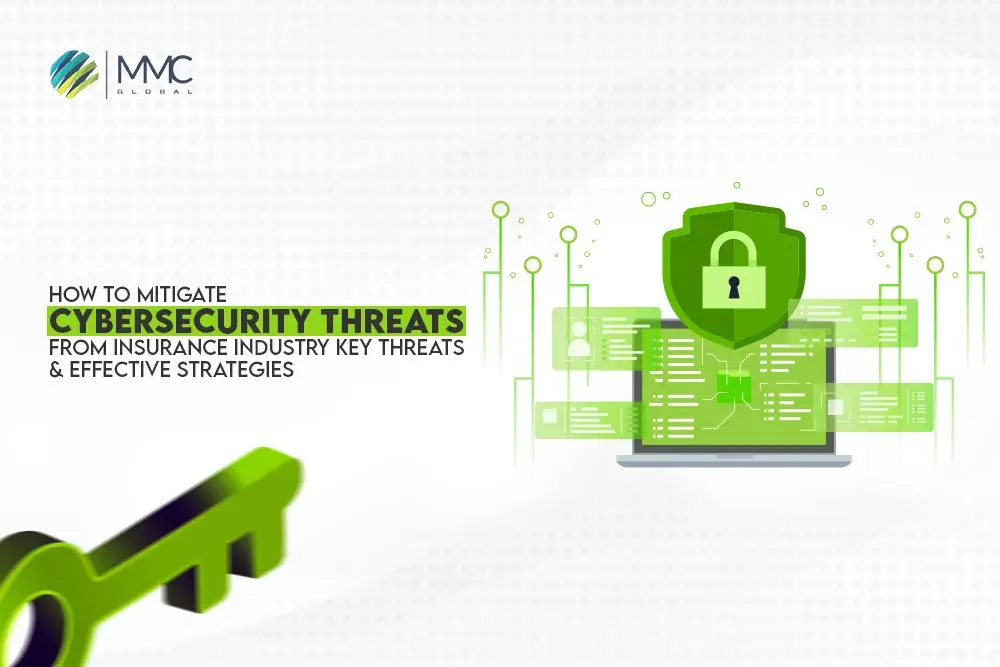How To Mitigate Cybersecurity Threats From Insurance Industry – Key Threats & Effective Strategies


Cybersecurity is one of the major concerns in the insurance industry as they possess a hefty amount of clients’ personal data in their repositories. This data includes personal, financial, healthcare, and other corporate-level data that require primary security to refrain from cybersecurity threats.
Establishing a digital-first company to cater to market demands helps expand businesses but is also associated with risks like data breaches, malware attacks, system disruption, social engineering, etc. Well-versed digitalization requires well-equipped cybersecurity consultation and technologies to manage vulnerabilities and respond in advance.
Moreover, cyberattacks & threats have a large network, where hackers use different technologies, techniques, and practices to attempt exploitations in computational systems and networking. In an era where data breaches and cyber-attacks are increasingly prevalent, the insurance industry is no exception to the risks posed by cybersecurity threats.
The insurance sector, with its vast repositories of sensitive client data and financial information, is a prime target for cybercriminals. To protect this valuable information and maintain trust, insurance companies must implement robust cybersecurity measures. However, this blog explores key strategies for mitigating cybersecurity threats in the insurance industry.
Cybersecurity Landscape In the Insurance Industry
Key Threats Facing the Insurance Industry
- Data Breaches: Insurers store extensive personal and financial data, making them attractive targets for hackers seeking to steal this information for identity theft or fraud.
- Ransomware: Ransomware attacks can lock insurers out of their systems, demanding a ransom for the release of critical data. This can disrupt operations and result in significant financial losses.
- Phishing Attacks: Cybercriminals often use phishing emails to trick employees into disclosing sensitive information or downloading malware, which can compromise the security of the entire network.
- Insider Threats: Employees, whether malicious or negligent, can inadvertently or intentionally compromise data security, making insider threats a significant concern.
- Third-Party Risks: Insurers often work with third-party vendors who may have access to their systems and data. Vulnerabilities in these third-party systems can pose risks to the insurer’s cybersecurity.
Strategies to Mitigate Cybersecurity Threats
Implement Comprehensive Cybersecurity Policies
Develop and enforce cybersecurity policies that address data protection, network security, and incident response. Ensure that these policies are regularly updated to adapt to emerging threats as well as technological advancements.
Key Elements to Include:
- Access Controls: Restrict access to sensitive data based on roles and responsibilities.
- Data Encryption: Encrypt data both at rest and in transit to protect it from unauthorized access.
- Incident Response Plan: Establish a detailed incident response plan to quickly address and manage any cyber incidents.
Invest in Advanced Security Technologies
Leverage cutting-edge cybersecurity technologies to enhance protection against threats. This includes:
- Firewalls and Intrusion Detection Systems (IDS): Deploy firewalls and IDS to monitor and protect against unauthorized access and attacks.
- Multi-Factor Authentication (MFA): Implement MFA to add an additional layer of security for accessing sensitive systems and data.
- Endpoint Protection: Use advanced endpoint protection solutions to guard against malware and other threats targeting devices.
Conduct Regular Security Training and Awareness Programs
Human error is often a significant factor in cybersecurity breaches. Regular training and awareness programs can help employees recognize and respond to potential threats.
Training Topics Should Include:
- Phishing Awareness: Teach employees how to identify and avoid phishing scams.
- Password Management: Emphasize the importance of strong, unique passwords and the use of password managers.
- Data Handling Procedures: Educate staff on proper data handling and storage practices to prevent accidental exposure.
Perform Regular Security Assessments and Penetration Testing
Regular security assessments and penetration testing help identify vulnerabilities before they can be exploited by cybercriminals.
Recommended Practices:
- Vulnerability Scanning: Conduct regular vulnerability scans to detect and address security weaknesses.
- Penetration Testing: Engage in penetration testing to simulate attacks and assess the effectiveness of existing security measures.
Ensure Compliance with Regulatory Requirements
The insurance industry is subject to various regulatory requirements that mandate specific cybersecurity practices. Ensure compliance with relevant regulations such as:
- General Data Protection Regulation (GDPR): For handling the personal data of individuals in the European Union.
- Health Insurance Portability and Accountability Act (HIPAA): For protecting health information in the U.S.
- Insurance Data Security Model Law: Enforced by state regulators in the U.S., requiring insurers to implement comprehensive cybersecurity programs.
Monitor and Manage Third-Party Risks
Assess and manage the cybersecurity practices of third-party vendors who have access to your systems and data.
Best Practices Include:
- Vendor Risk Assessment: Evaluate the cybersecurity posture of third-party vendors before establishing a relationship.
- Third-Party Agreements: Include cybersecurity requirements in contracts and ensure vendors adhere to these standards.
- Continuous Monitoring: Regularly monitor the cybersecurity performance of third parties to ensure ongoing compliance.
Develop a Robust Data Backup and Recovery Plan
Regularly back up critical data and ensure that backup processes are secure and reliable. Moreover, a robust data backup and recovery plan is essential for minimizing downtime and data loss in the event of a cyber incident.
Backup Best Practices:
- Regular Backups: Schedule frequent backups to ensure that the most current data is available for recovery.
- Offsite Storage: Store backups in a secure offsite location to protect against data loss due to physical damage or ransomware.
Foster a Culture of Cybersecurity
Creating a culture of cybersecurity within the organization helps to ensure that security practices are integrated into daily operations and decision-making.
Steps to Foster a Cybersecurity Culture:
- Leadership Commitment: Secure commitment from senior leadership to prioritize cybersecurity.
- Employee Engagement: Involve employees in cybersecurity initiatives and encourage them to report potential threats.
- Continuous Improvement: Regularly review and improve cybersecurity practices based on feedback and evolving threats.
Conclusion
Mitigating cybersecurity threats in the insurance industry requires a comprehensive approach that includes robust policies, advanced technologies, ongoing training, and rigorous assessments. By implementing these strategies, insurance companies can better protect their valuable data, maintain regulatory compliance, and build trust with their clients.
As cyber threats continue to evolve, staying proactive and vigilant will be key to safeguarding the future of the insurance industry. Partnering up with MMC Global, you will get a consultation with cybersecurity experts who help you detect and protect your business with strong security implementations. Let’s start with us today!



